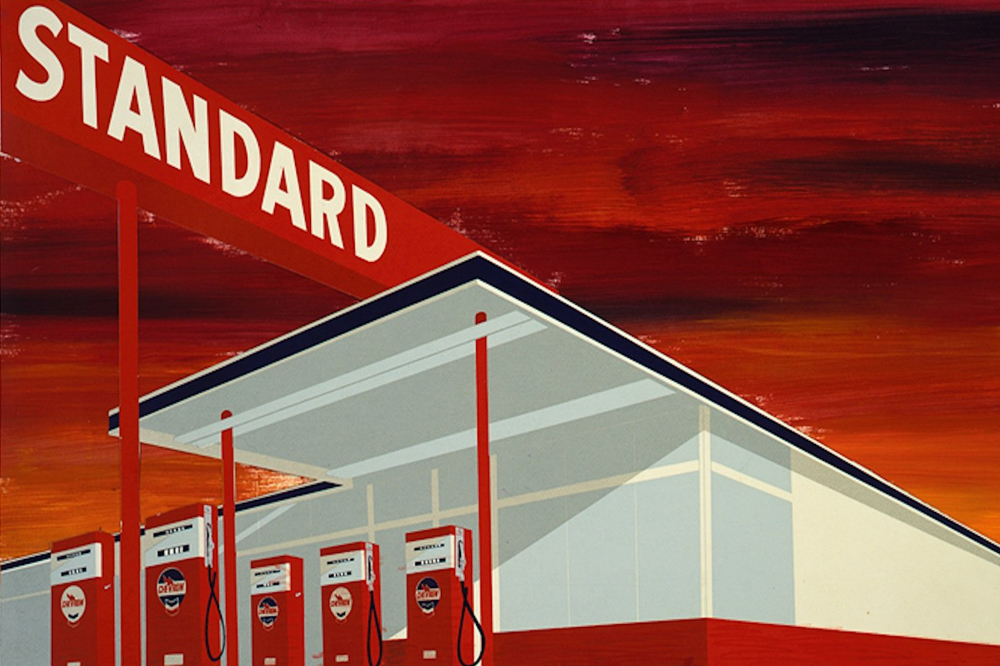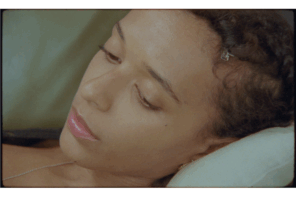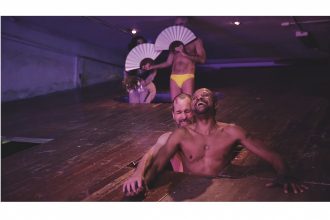First you pass through a canyon of glass bank towers, hugging the 110 on either side, concrete overpasses and underpasses, off-ramps and onramps, exits and service lanes. The cars and trucks and vans merge back and forth, always a chug and sputter except for late at night and this is late afternoon. The 101 picks up in Chinatown and swings you north through Echo Park. The freeway curves to some kind of straightaway. The bottleneck snaps as the car revs up and that’s when you catch the first glimpse of this sunset.
An ice-cream orgy and a champagne supernova, the clouds interplanetary sheep stumbling over chocolate hills covered in strawberry syrup and root-beer. Either premonition or prayer, you spot the long thin letters just beneath froth and cream, they whisper a distant white “Hollywood.” You flick your wrist and a song comes on. The freeway’s moving fast now and you’ve got a chorus to bask in all that smeary color, bright as a dying sun.
The headlights of the passing traffic flicker on to the left, in front of you a forest of red tiger-eyes peering back. You pass Melrose and shimmy over to the right-hand lane, crossing your dotted lines with a blink. You spot the peak of the purple Brutalist spaceship the Seventh Day Adventists use as a church and the KTLA tower, totally defunct since they switched to digital waves, still stretching its steel skeleton high over the freeway, a praying mantis looking for its lover.
You spiral onto Sunset Blvd and into Hollywood, the streets lined with skinny palm trees, their funky fronds swaying in a sweet breeze. A gas station, bright-eyed and blank-faced, winks from the side of the road. Either you just left or you just entered an Ed Ruscha painting. It lasts as long as the sunset colors the sky.
But wait, I’d always hated sunsets in art.
A punk with too many buttons pressed, I was sick of everything good becoming an advertisement. Too easy a beauty, too obvious, and hardly something we could improve upon. Sublime, majestic, epic, humbling; yes, sunsets are all those things and more. A quotidian epiphany, only mawkish idlers and groping teenagers usually find time to bask in its lusty, lustrous grind. And these days, the most painfully schmaltzy cliché of all time.
All the propagandists and true believers handily hitch its epic grandeur to dictators and deities, toothpaste and anal itch cream. Fingers of light beam pious penumbras around anyone or anything needing the look of divine force. Halos are a dead giveaway for any kind of holiness. Every would-be saint is a sun god, beaming more watts than a tanning salon.
No matter how easily claimed sunsets may be, I’m not so hardened to turn them down when they come banging their colors against my windows. And in Los Angeles, they come every evening.
The smear of colors that make up a sunset in Los Angeles: golden brown and harvest gold; ancient amber and fresh citrine; peach and apricot and pumpkin; cotton-candy pink and Halloween orange; bittersweet vermilions and burnt ochre; bronze and brass and mummy brown; amethyst and lavender and mauve; flame and curry and a just a squeeze of navel orange; a streak of blood, a cerise stain, a droplet of wine; robin’s egg and ultramarine and sky blue, of course; carroty sodium streetlights and glittering smoggy browns; a bruise radiating from freshest blue to fading yellow.
All that prismatic sunlight gets sucked from the sky and into the bodies of our citizens, filling them with solar heat for the cool nights under shadeless trees. All of it lit with the cool glow of neon and streetlamps and headlights and the darting tongues of flickering matches and lighters. When the wildfires burn, the orange light licks the sky long past close of day, and their smoke only thickens into richer beauty a sunset’s colors. When the soot and ash rain over the cars, the air suffuses with the smoky aroma of a campfire. It feels wrong to find pleasure in the smell.
Though others probably painted the smoggy smear of the LA sunset, Ed Ruscha did it best, elevating rather than bringing it down. The Obamas agreed, hanging one in the White House. Whether gridded with streets or marked with words. Sometimes they even say “Sunset” denoting only the street in LA. The colors speak for themselves.
Probably every painter with a ray or two of romance in their blood has deigned to paint a sunset. Some better than others. The nineteenth century had its array of sunset lovers. Corot’s bland pastorals choked on dust at dusk. American Thomas Cole’s suns set with facile sappy burst, glowing with cheap ass religion like a Jimmy Swaggart backdrop. Albert Bierstadt’s chased his setting sun into the Pacific, following the US flag across the continent with divine entitlement, riding manifest destiny like an iron horse. The Europeans range from melancholia to visionary. Karl Friedrich Schinkel’s bloom with watery blue, while those of his fellow German Caspar David Friedrich loom with furtive spirituality and ruination, truly crepuscular. “Oh Götterdämmerung,” sigh his suns. JMW Turner had eyes only for catastrophic lightshows over a windswept navy (not surprisingly the source of his native Britain’s power). Monet’s stillest haystacks are turbulent with twilight color. Van Gogh’s end of days bleed with frightening golds and reds.
In the following century, the setting sun took on industrial hues and maddening shape. Edvard Munch’s darkening skies undulate with insanity. Even Georgia O’Keeffe’s sunset in 1916 is a toxic magenta halo. In Edward Hopper’s Railroad Sunset, (1929) the signal tower’s stark silhouette frames nature, here only a backdrop for human progress. Lyonel Feininger’s Sunset at Deep (Sunset) (1930) reveals light coming to pieces in broken angles and splintered visions along with the rest of the world. Picasso never painted a sunset as far as I can tell. I did find one by Matisse, Young Woman at the Window, Sunset, (1921) but this twilight is merely a wash of mauve through a window. The only way left it seems for Matisse to see a sunset.
After the war, the sunset became what it is now. Kitsch. Lichtenstein’s sunset series makes dusk a stylized cartoon. Warhol’s “Sunset” series of prints from 1972 look like plays with color on the most popular of popular images. “I was going for the cliché,” said Dan Graham about his Sunset to Sunrise (1969) when interviewed by Eric de Bruyn in 1996. Irony felt like the only defense against this onslaught of easy imagery beaming from televisions and smirking from billboards. And artists, they started wearing “criticality” like a flack jacket.
Since this nadir of ironic detachment, a few artists in recent years have reclaimed the sunset, but mostly as another jab at its overwrought and overused pictorial beauty. While they seem to know sunsets are a cheap ploy, you can see beneath their smartish games an actual affection. Anne Collier’s Studio Sunset (2007) isn’t a sunset but a photograph of a poster of a sunset. In Lisa Oppenheim’s The Sun is Always Setting Somewhere Else (2006), the artist takes a series of photographs (pulled together into a 35 mm slide show) of sunsets with postcards of sunsets covering the real thing. Real romantic engagement with sunsets in art feels almost impossible, always mediated by other images we’ve seen of sunsets, as if we can’t even see without some previous emotional manipulation coloring our eyes. Walking through the sands along the cliffs of Point Dume recently, one of my companions said, “This beach is so beautiful, it’s like a tampon commercial.”
David Horwitz’s snapshots feel quite unabashedly romantic, even though they exist as images he tried to illicitly slip into Wikipedia as pictures of himself watching sunsets along California beaches. Its title Public Access (2011-14) comes from both the California state law that all beaches up to tideline must be accessible to the public as well as Wikipedia’s rules and presumptions about the nature of free images (and the anger of its editors at feeling pranked by Horwitz, their community wiping the record of his images).
It’s hard to find a work by Friedrich Kunath that isn’t a sunsetty smear bordering on tie-die love-in. But like Horwtiz, Kunath’s heartfelt and almost unpolluted romance can’t exist without the whisper of a joke. Whether pinching the setting sun along a beach between his fingers; or in two paintings with bludgeoned skies, he scrawled across one, “Fuck it, I love you” and the other “I need to be more romantic.” In one re-appropriated photograph, the jet-plane taking off into the burnt-orange of the setting sun, instead of Pan-Am or whatever, reads simply Problems. Kunath can’t look at the California sky at the end of the day without honest and earnest emotion, but also a grin. Even the brilliant and caustic Mike Kelley couldn’t help but mimic a schmaltzy album cover for the cover of his book Day is Done (2007), the original inspiration appearing in his print Double Sunset from 2005. The book cover is completed with nary a knowing sneer. The artist stands in shadow, the sun dips into the ocean behind him in the fading light. Day is done.
But I still land back at Ruscha. He could have been mocking the cheesy romance of LA boosterism or celebrating the magical colors of California sunsets, or both. The deadpan of his work allows for both readings. And this complexity is the true spirit of sunsets in our times. We project what we want so long as we know it’s both a manipulation and a beauty, a cheap trick and the truly sublime. Whether Ed’s cracking a dry joke or professing an honest affection, I can’t separate his work from the skies I see everyday. I love every sunset even as I know that the ease of its aesthetic will end up in the worst and most cynical commerce. I don’t let it get me down anymore. This feels generational. We all know how shitty capitalism can be, how someone will try to manhandle every authentic feeling for their own mean profit, but we find our own emotions and love and anguish for ourselves all the same. On the other side of cynicism, I’ve found romance.
This is not some twee denial of a hard world. We find beauty and meaning on the other side of suffering and manipulation and despite it. I see it in art, mostly in LA, but I’m sure it exists elsewhere.I see it in Samara Golden’s heartstruck fifth-dimensional installations, a projected sun drops behind memories and mirrors. I see it in the quiet repetition of sunset photographs throughout rooms suffused with essential scents by Ginger Wolfe-Suarez. It only makes sense that here in the heart of the heart of profiteering entertainment, a generation finds the numbness fading away.
The sun dips behind the hills. You flick your wrist again and a new song comes on, its silvery synths dance and thrum. Stopped at a red light, you watch the big-bellied moon rise over Sunset Blvd. You can see every hard sea and scar in its soft glow, full of promise and permission. The light changes to green. Your eyes shift back to the traffic and you drive on into the Los Angeles night.



























